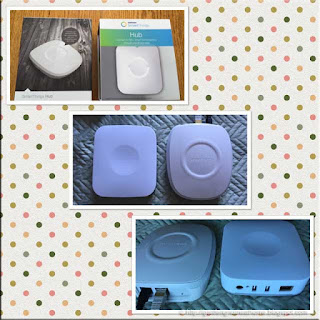Yesterday, I shared a few more thoughts on our smart home. I honestly would have set up my X-10 components in this house. Even though it is an old (1970's) technology it does still work although there can be problems with dirty signals. We bought our Nest the first year here and it was love at first sight! Unlike traditional programmable thermostats, the Nest can also be controlled via a cell phone app which became a huge benefit. We have no kids or pets at home so staying overnight on a whim is normal. If using a traditional programmable thermostat, the temperature would be set to the schedule but with Nest the temperature settings is automatically set to "away" or it can be manually adjusted through the app. Last year heading home from our vacation home, the anticipated two day trip ended up being a straight drive though so we simply used the app to warm the house by the time we arrived home. This had me itching to be able to do the same thing with other home automation.
The brains behind the connected home automation is a hub. Devices are
paired to the hub. The devices communicate to the hub which deciphers
the signal, sends it to the cloud which then sends back a signal causing
the device to perform as desired. The hub essentially allows remote
access to the devices. When you are away from home and want to control a
device manually, you open the app and tap on the desired device to turn
on, off or dim. This sends a signal to the cloud which sends to the
hub at your house which sends the signal to the device to perform as
desired. All this happens in seconds. Some hubs are propriety (Iris,
Staples D-Link), some are Z-wave only (Vera) and some like Wink and
SmartThings are capable of controlling multi-brand, multi-language
(ZigBee, Z-wave, Bluetooth, WiFi). It is also compatible with IFTTT app for additional rules and schedules. Wink only controls ZigBee, Z-wave
and some WiFi but be warned that its parent company has filed bankruptcy
and Wink is for sale so this is not one to invest money in.
A smartphone (iOS 6, Android OS 4.0) and internet connection is required for the setup of the hub. I downloaded the SmartThings App then set up my SmartThings Hub 1 (ZigBee, Z-wave, WiFi). It came with an ethernet cord for a secure connection and power cord. When first connected, the hub updated then was ready to connect devices. I only had 3 bulbs at that time, a GE Link and 2 Cree. They paired nicely so I was off shopping. What I really liked was being able to customize. PEQ motion sensors (made by Centralite) were on sale for $19.99 so I checked the forums to find they worked with SmartThings even though they aren't on the list. I bought 3 motion sensors, three more Cree bulbs and three-way switch which brought immediate home automation with lights being controlled by motion/occupancy rather than just schedules. SmartThings Hub 2 was announced shortly after I got my Hub 1, with a expected third quart release. It was delayed but I knew I was going to buy it anyway. In the meantime, I continued adding devices to my system.
I pre-ordered SmartThings Hub 2 (ZigBee, Z-Wave, Bluetooth,WiFi) on Sep 9 and was pleasantly surprised when it arrived six days later. Hub 2 (colour box top, middle left, bottom right) has an updated square design and updated features like battery back-up. It came with an ethernet cable, power cord and 4 AA batteries. There is LED indicator light on the front of the hub for a quick visual of hub status. Hub 2 has two USB ports for local image storage and offers the coveted local control. It is limited local control but still an improvement. Like Hub 1, a smartphone (iOS 7+, Android OS 4.0+, Windows Phone 8.1+) and internet connection is required to setup the hub. The hub software will be updated during the process before any devices can be added. The updated app has "Smart Monitor" which can be armed (away, stay) and disarmed similar to a home security system which is a nice feature. Devices (things) once paired can be placed in rooms making it easy to find them for control. The devices can be controlled manually, via SmartApps, and Routines.
Currently there is no migration tool for moving devices from Hub 1 to Hub 2. This becomes a project with larger number of devices. I had a problem with the app recognizing the hub even though the hub was showing in the IDE. Despite trying several solutions, I had to get help from support. Once they solved that problem, I had most of my 30 devices up and running. I had to redo my schedules and rules but in one way that was a good thing as it helped clean up my configurations a bit. Other than that, the migration was rather smooth.
Of note, you cannot use two hubs in the same location. That means there will likely be a lot of Hub 1 for sale in the near future. There is no need to upgrade to or even start with Hub 2 unless you want the new features Hub 2 has to offer. Rumour has it that Hub 3 is already in the works so some with Hub 1 are holding out for it.
Next up: components of our smart home


















0 comments:
Post a Comment